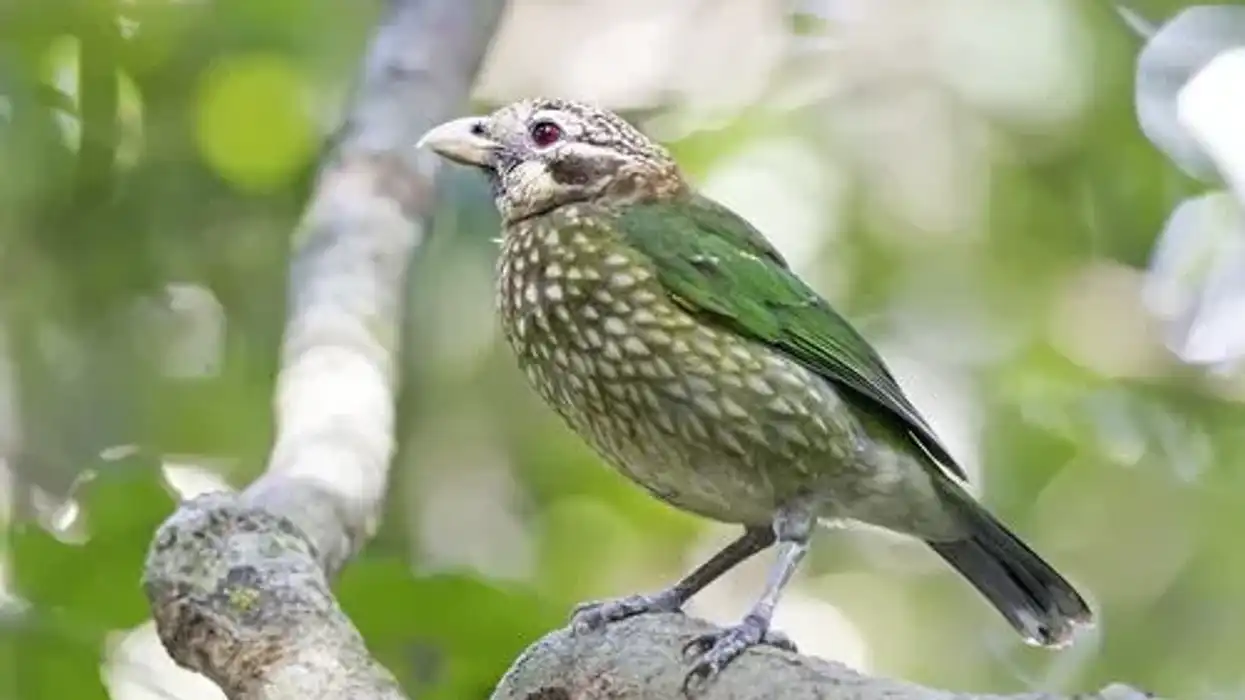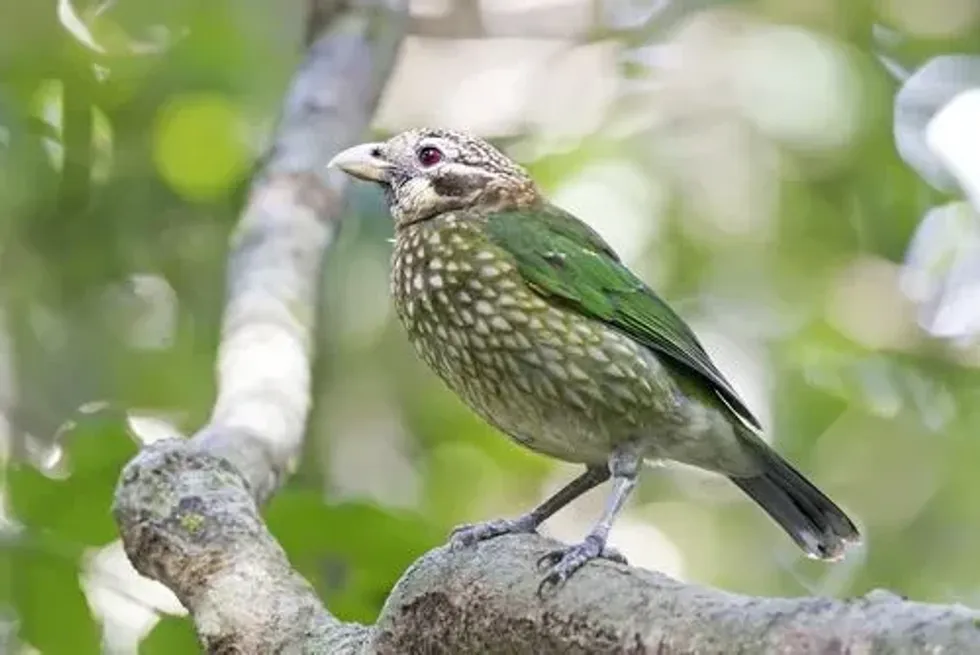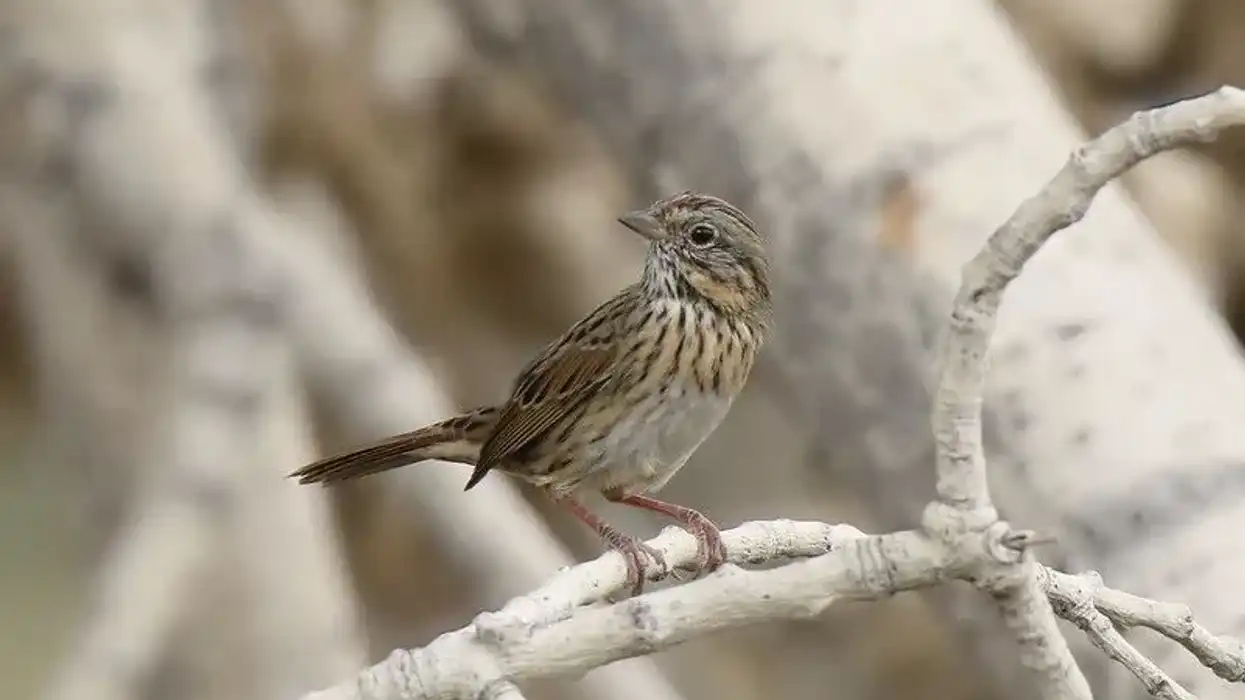While the tropical rainforests of Australia are home to a diverse selection of wildlife, nothing perhaps can beat the spotted catbird. Yes, they may look like any other colorful rainforest bird, but its distinct, cat-like wailing call is one that cannot be ignored!
The spotted catbird (Ailuroedus maculosus) of the Ptilonorhynchidae family is a species of bowerbird native to north Queensland (Atherton Tablelands south of the Burdekin River), New Guinea, and the eastern Moluccas. Like its distinctive cat-like call usually heard at dawn and dusk, the spotted catbird has a unique appearance.
The plumage present on the upper parts of the body is emerald green, and the underparts are olive green with pale spots. The ivory-colored bill has a hooked tip.
The spotted catbird habitat comprises lowland and upland tropical rainforests as well as orchards and gardens.
The Australian bowerbird species is an omnivore, feeding on a diet comprising primarily of berries, drupes, arthropods, and occasionally nestlings and birds' eggs. Spotted catbirds have a pretty common and widespread distribution throughout their natural range in Australia and are listed as a species of Least Concern in the IUCN Red List.
There is a lot more to Australian spotted catbirds. Read on to explore lots of interesting facts about this bowerbird species!
If you like what you read, do check out equally interesting and mind-blowing facts about the broad-billed hummingbird and green kingfisher.
Spotted Catbird Interesting Facts
What type of animal is a spotted catbird?
The spotted catbird (Ailuroedus maculosus) is a bowerbird species native to north Queensland in Australia, eastern Moluccas, and New Guinea. These birds belong to the Ptilonorhynchidae family.
What class of animal does a spotted catbird belong to?
The spotted catbird (Ailuroedus maculosus) belongs to the class of birds.
How many spotted catbirds are there in the world?
An estimate of the global population size of spotted catbirds is not available. However, the International Union for Conservation of Nature (IUCN) Red List reports the species as having a globally decreasing population trend.
Where does a spotted catbird live?
The natural distribution range of the spotted catbird (Ailuroedus maculosus) includes the Atherton Tablelands in north Queensland, New Guinea, and the eastern Moluccas. In Australia, the species has two isolated populations in north Queensland, one in Cape York and the other in the wet tropics further south.
While the species is mostly resident in its range, it may undertake some migration to lower elevations during the non-breeding season.
What is a spotted catbird's habitat?
The habitat of the spotted catbird (Ailuroedus maculosus) primarily includes the tropical rainforest regions of Australia. Australian spotted catbirds inhabit lowland and higher altitude tropical rainforests and wet sclerophyll forests, preferably at elevations lower than 2,953 ft (900 m).
These birds of the wet tropics of north Queensland usually forage in the upper and middle stories of the rainforest. However, these birds can forage in several elevations and may even browse for food on the ground.
Instead of making a bower, these spotted catbirds build a deep, open bowl-shaped nest. The nest is solely built by female birds.
The nest is mostly made of leaves with an inner lining of mud pieces or decaying wood pulp. The lining of the egg cup is cushioned by soft tendrils and fine twigs. Besides their wild habitat in the tropical rainforest, spotted catbirds may also be found in orchards and gardens.
Who does a spotted catbird live with?
The spotted catbird (Ailuroedus maculosus) forms monogamous nesting pairs that last several years. Monogamous pair formation is a common trait of catbirds in the genus Ailuroedus. Both the male and female birds are defensive of their all-purpose territory. These birds are reported to forage alone, in family parties, or in pairs.
How long does a spotted catbird live?
The oldest recorded age of the spotted catbird (Ailuroedus maculosus) is more than 19 years.
How do they reproduce?
The breeding season of the spotted catbird (Ailuroedus maculosus) spans from August-March, peaking during October-December. The formation of monogamous pair bonds is common among the species.
The female bird builds a bowl-shaped breeding nest, usually 3.3-23 ft (1-7 m) above the ground in climbing vines or saplings. Post breeding, the females lay a clutch comprising one to three eggs which are incubated for about 22-23 days. The eggs are oval, cream-colored, glossy, and laid on alternate days.
The average nesting period spans 19-20 days, with both the male and female parents feeding the young birds. Moreover, the parents are quite invested in caring for their young, as evident from the aerial display that the parents perform to distract predators.
What is their conservation status?
As per the IUCN Red List, the spotted catbird (Ailuroedus maculosus) of Australia is a species of Least Concern.
Spotted Catbird Fun Facts
What does a spotted catbird look like?
Adult spotted catbirds have a large head and an overall stout build. The plumage on the upper parts is emerald green, and the underparts are pale olive green with distinctive spottings.
The large head is dusky-colored with a blackish cap. There is a prominent black patch below the dark red eye. In addition, these birds have a white-tipped green tail and slim, white bars on the wings.
The legs and feet have a bluish-gray color, and the beak is ivory-colored with a hooked tip. Males and females of the species have similar plumage and are visually indistinguishable.
The cryptic plumage pattern of spotted catbirds differs from other species of bowerbirds and helps the former to easily blend into foliage while foraging. Even though the spotted catbird's breeding range supposedly overlaps with the green catbird (Ailuroedus crassirostris), the two look pretty different.
For instance, the green catbird has a green head and crown without any black patch near the ears. The green catbird is found in northeastern New South Wales and southeastern Queensland in Australia.

How cute are they?
The plump and colorful physique of the spotted catbird (Ailuroedus maculosus) makes this bird look not only cute but also extremely beautiful.
How do they communicate?
Spotted catbirds are known for their peculiar cat-like wailing calls that almost sound like a cat meowing, or a baby crying. The calls are loud nasal sounds comprising sharp clicks and cries.
Even though the adults call at almost all times of the day, the typical cat-like yowling calls are most common at dawn and dusk and more frequent when the temperatures are cooler. A wailing territorial song of pair members is common throughout the year.
How big is a spotted catbird?
The spotted catbird size ranges between 11-11. 4 in (28-29 cm). They are slightly larger than flame bowerbirds of the genus Sericulus and the Ptilonorhynchidae family. Another passeriform, the gray catbird of the genus Dumetella, is also a few inches smaller than the spotted catbird.
How fast can a spotted catbird move?
The movement speed of the spotted catbird is not known.
How much does a spotted catbird weigh?
The male adults are heavier than their female counterparts. While the males weigh about 6.35 oz (180 g), the body weight of female spotted catbirds is around 5.92 oz (168 g).
What are the male and female names of the species?
Spotted catbird males and females do not have distinct names. They are simply referred to as male or female.
What would you call a baby spotted catbird?
Like most other young birds, a baby spotted catbird is called a chick, nestling, or fledgling.
What do they eat?
The spotted catbird and its babies have an omnivorous diet, with a major chunk of the diet comprising berries, drupes, fruits, stems, flowers, and plant sap. The animal diet of these birds mostly includes arthropods, other birds' eggs, and nestlings.
The young birds are primarily fed fruits like figs, insects like cicadas, earthworms, and other invertebrates found amidst leaf litter. The spotted catbird's foraging behavior is pretty unique, with individuals searching the ground for food, assisted by their powerful bills and strong feet.
Are they poisonous?
The spotted catbird is not known to be poisonous.
Would they make a good pet?
It is not common to have a spotted catbird as a pet, mainly because it is a wild bird that may not be suited to a domestic environment. Besides, the cat-like cry of these birds is not very soothing to the ears.
Unlike the gray catbird (Dumetella carolinensis), which is known to be friendly, nothing is known about the temperament of the spotted catbird around humans.
Did you know...
Until 2016, the spotted catbird was considered a subspecies of Ailuroedus crassirostris.
Even though the spotted catbird is a species of Least Concern, it is threatened due to habitat destruction. To this end, efforts to revegetate the Atherton Tablelands in north Queensland have brought about some habitat diversity.
A catbird can be one of three types ,Australasian, New World, or Abyssinian. While the green catbird and spotted catbird belong to the Australasian group, the gray catbird is a New World species. The gray catbird belongs to the Mimidae family, which includes mockingbirds.
What does a spotted catbird sound like?
Ailuroedus maculosus has a typical nasal cat-like cry that often sounds like a wailing baby. Its calls are pretty loud, lacking in melodic content, and can be heard from quite afar. Even though these birds can be heard calling at all times of the day, calls during dawn and dusk are most common.
Why are they called catbirds?
Catbirds are actually songbirds. Their distinctive wailing calls sound like a cat meowing, earning these birds their common English name. Even the genus name 'Ailuroedus' is Greek for 'cat-voiced' or 'cat-singer'. Indeed, the species' taxonomy is pretty interesting!
Here at Kidadl, we have carefully created lots of interesting family-friendly animal facts for everyone to discover! For more relatable content, check out these gray kingbird facts and golden bowerbird facts for kids.
You can even occupy yourself at home by coloring in one of our free printable gray catbird coloring pages.
Second image by John Manger, CSIRO









